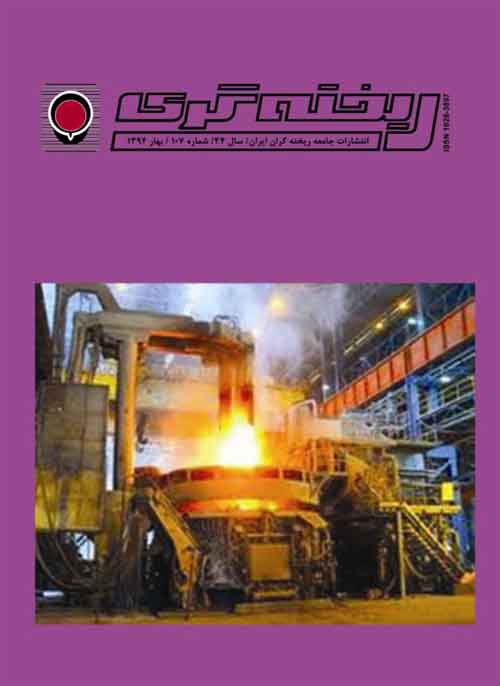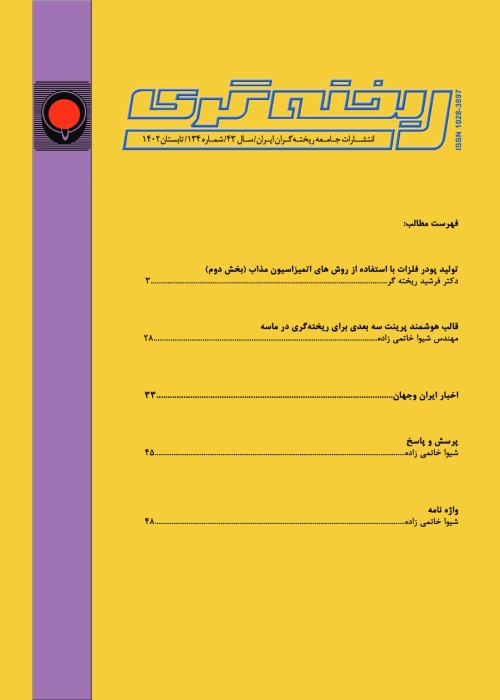فهرست مطالب

نشریه ریخته گری
پیاپی 107 (بهار 1394)
- تاریخ انتشار: 1394/03/30
- تعداد عناوین: 8
-
-
بررسی تاثیر فرآیند نیمه جامد SIMA بر ریز ساختار و سختی آلیاژ منیزیم AZ91صفحه 2
-
مروری بر فرایند ریخته گری گردابی و چالش های آن در ساخت کامپوزیت های زمینه فلزیصفحه 14
-
مقایسه مکانیزم تشکیل عیب عرق فسفید و زخمه در قطعات ریخته گری چدن خاکستریصفحه 28
-
بررسی تاثیر آمیژان های Al-8B و Al-5Ti-1B بر ریزساختار و خواص مکانیکی آلیاژ AL-518صفحه 38
-
بررسی تاثیر سیکل عملیات حرارتی پس از جوش روی ریزساختار و خواص مکانیکی در منطقه متاثر از حرارت در فرآیند جوشکاری القایی فرکانس بالا فولاد API X60صفحه 47
-
بررسی شکست محور اصلی خودروی نیسانصفحه 55
-
بررسی ارتباط نوع طراحی راهباره بر تشکیل حفرات انقباضی در قطعه ریختگی چدن خاکستری مورد استفاده در صفحه فشار خودرو از طریق شبیه سازی با نرم افزار ESI ProCASTصفحه 62
-
بررسی اثر پیرسازی دومرحله ای روی ساختار و خواص مکانیکی آلیاژ Ti-6Al-4Vصفحه 73
-
Effect of SIMA Semi-Solid Process on Microstructure and Hardness of AZ91 Magnesium AlloyPage 2In this paper, plastic deformation and strain induced melt activated (SIMA) semi-solid heat treatment has been used to study the changes in microstructure and hardness of AZ91 magnesium alloy. 10%, 15% or 25% of warm rolling were applied on the samples at 280°C and deformed structure was exposed to 550°C and 570°C for 20 minutes in heat treatment furnace. Eutectic phases and Mg17Al12 intermetallic compound started to melt within inter-dendritic spacing, leading to a non-dendritic microstructure. Due to three main mechanisms of recrystallization, melting and coalescence, secondary and primary α dendrites broke into smaller pieces and reshaped to spherical grains. Finally, by decreasing the temperature, molten phase solidified and produced a microstructure containing spherical α grains among eutectic phase network.Keywords: Magnesium alloy, AZ91, Microstructure, Semi-Solid, SIMA, Hardness
-
A Review of Stir Casting Process and Its Challenges in Fabricating Metal Matrix CompositesPage 14In this paper, stir casting process is introduced which is the simplest and the cheapest technique available for producing metal matrix composites; and the most crucial shortcomings and challenges facing the process are presented. In addition, it has been attempted to concisely depict the mechanisms, phenomena and involved factors. The shortcomings affecting the properties of produced composite adversely include non-uniform distribution of reinforcing phase, high porosity, and weak bonding between matrix and reinforcement. They have a close and entwined relation with each other, and are believed to be influenced by stir casting parameters such as melt temperature, holding time, pouring rate, size and position of impeller, stirring speed, and so on. Eliminating or minimizing such shortcomings to an acceptable level through optimization and proper selection of the process parameters is achievable. Consequently, it can come in so useful for widespread acceptance of metal matrix composites and expanding their applications which are currently limited in spite of having excellent properties. However, a more precise study and deeper understanding of the phenomena associated with the aforementioned challenges are still seemed to be necessary.Keywords: Metal Matrix Composite, Stir Casting, Particle Clustering, Porosity, Wettability
-
On the formation mechanism of sweat phosphide and Scab in the gray cast iron castingsPage 28The present study compares the formation mechanism of two common defects in gray iron castings, sweat phosphide and scab. Normally, when a solid layer occurs on the surface of grey iron castings, it is called scab. In this study we compared these two defects by means of standard Metallography procedure and scanning electron microscopy. The result indicates that is accompanied by sand particles beneath the solid layer and its microstructure are identical with the casting. While, there are no sand particles beneath the sweat phosphide and its microstructure differs from casting.Keywords: Scab, sweat phosphide, grey cast Iron, steadite, shrinkage
-
Effect of Al-5Ti-1B and Al-8B Master Alloy on Microstructure and Mechanical Properties of A518 Aluminum Casting AlloyPage 38The current study has been devoted to improve toughness and increase the mechanical propertie of A518 aluminum casting alloy by adding Al-5Ti-1B and Al-8B grain refiners. Micro and macrostructure investigation after adding various amount grain refiner (0.01, 0.03, 0.05, 0.1, 0.3, 0.5, 1% weight percent) was performed by light and electron microscopy. It was found that refined specimens have more homogenous microstructure and finer grains in comparison with un-refined specimen. when the Ti and B containing master alloys were added to alloy, the morphology of columnar alpha dendrites turn into rosette like and semi globular, respectively. The results also illustrate that, Ti have stronger effects on grain refining and mechanical properties in comparison with B addition. Frctographic study showed that the fracture surface of specimens after grain refining have more and finer dimples.
-
Evaluation of Post-Weld Heat Treatment Cycles Effect on Microstructure and Mechanical Properties at Heat Affected Zone in High Frequency Induction Welding Process of API X60 steelPage 47Steel pipelines for the transmission of gas and oil may extend thousands of kilometers and they represent one of the most sophisticated engineering achievements of the modern era. Some of the steel tubes are manufactured from plates which are formed into an appropriate shape and then seam welded. An efficient and high productivity process for achieving this involves high-frequency induction welding in which the abutting surfaces are forged together following localized heating. This disrupts the structure of the steel, so the joining operation is followed immediately by one or more induction heat-treatments, with the aim of regenerating the properties degraded by the welding operation. It is found, unfortunately, that the toughness at the location of the weld junction does not improve as a result of the heat treatment. An investigation of this phenomenon is the essential aim of this paper.Keywords: Microalloyed steel, Heat treatment, Welding
-
The Studying Cause of Failure Drive Shaft of NISSAN CarPage 55Identify the cause of the failure of parts for all relevant including consumers and producers is important. For example, from the perspective of the consumer determine the cause of failure pieces can be legal aspects and from the point of view of the manufacturer to reform the process and avoid its repetition. Most failures were reported in the world is Fatigue-related failure. This failure occur under cyclic stress and tensions much lower than the tensile strength of the piece without warning and suddenly. In this study, using a laboratory chemical analysis, hardness, microstructure and fracture surface analysis main cause of failure of a Nissan car was studied. The studies conducted showed avulsion and fine cracks in the surface due to rough machining and river lines of fatigue failure in the piece surface which eventually led to its failure.Keywords: The main axis of the vehicle, fatigue failure, machining
-
Investigation of the runner design on formation of shrinkage porosities in gray cast iron pressure plate by ESI ProCAST simulation softwarePage 62The present study investigates the dependency of microshrinkage formation to the thickness and shape of gates in casting of pressure plates from grey iron. Using casting simulation software (ESI Procast) we analyzed the solidification process of the pressure plates in vertical disamatic line and suggested a new design for the ingates of the casting. Casting that were produced with old design showed a considerable amount of microshrinkage in gates, however, with new design, there was no sign of microshrinkage in the castings. The presence or absence of the microshrinkages were determined with standard metallography procedure.Keywords: ESI Procast, Pressure plate, ingate, Gery Iron
-
The Influence of Two Steps Aging on Structure and Mechanical Properties of Ti-6Al-4V AlloyPage 73Effect of double aging behavior of Ti-6Al-V alloy, two samples of base alloy and with added 0.03wt carbon alloy were first aged at 350°C for 1 hour and then again at 550°C for 1 hour after that structure and tensile strength of samples have been studied to compare results with single aging at temperatures 350°C and 550°C for 2 hours. Investigation results showed that strength of both alloys in aging at 550°C are more than 350°C and ductility of the base alloy content at 550°C is lower than 350°C, while the ductility of carbon contained alloy in both of temperature are the same. Also, this research showed that in double aging treatment, because of more homogenous and finer structure, ductility has been improved and higher strength has obtained in comparison to single aging. In first step of double aging, Carbon content leads to increasing nucleation sites in final step and consequently structural refining and increasing ultimate tensile strength for about 20% and reduction area for about 58%.Keywords: Double Aging, Carbon Content, Ti-6Al-4V Alloy, Tensile Properties


